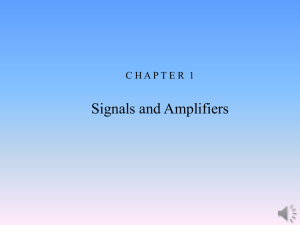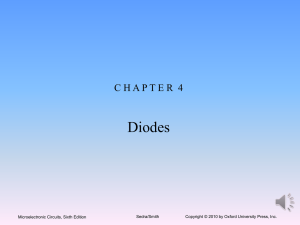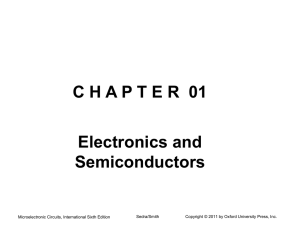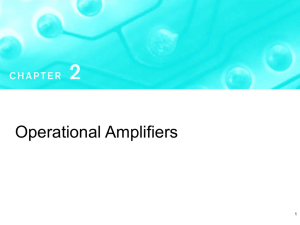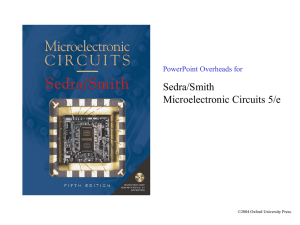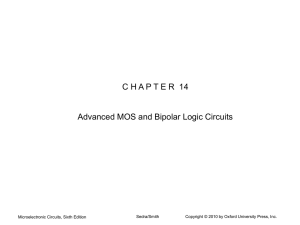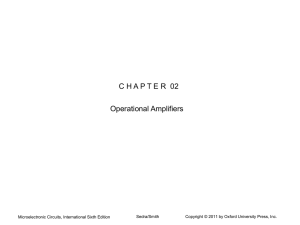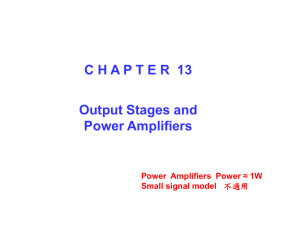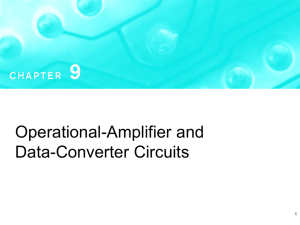sedra42021_ch08FeedbackStabilityEdited
advertisement
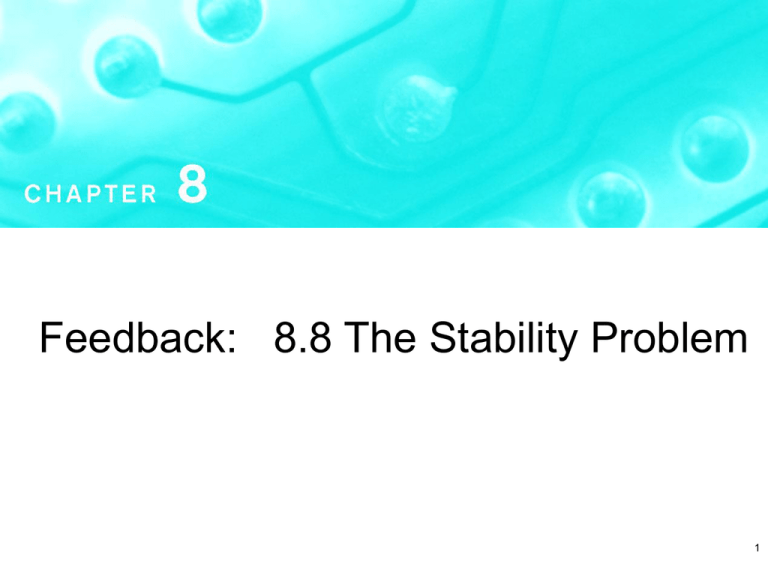
Feedback: 8.8 The Stability Problem 1 8.8.1 Transfer Function of the Feedback Amplifier A s Af s 1 A s s A j Af j 1 A j j Figure 8.1 General structure of the feedback amplifier. This is a signal-flow diagram, and the quantities x represent either voltage or current signals. Microelectronic Circuits - Fifth Edition Sedra/Smith Copyright 2004 by Oxford University Press, Inc. 2 8.8.1 Transfer Function of the Feedback Amplifier Loop Gain: L j A j j A j j e j Suppose that there is a frequency, 180, for which j 180 180 180 e e j180 1 Then A j Af j 1 A j j Microelectronic Circuits - Fifth Edition Sedra/Smith Copyright 2004 by Oxford University Press, Inc. 3 8.8.1 Transfer Function of the Feedback Amplifier Af j If A j 1 A j j A j j 1 , then Af j A j (Armstrong’s “regeneration”) If A j j 1 , then Af j (Armstrong’s “oscillation”) Microelectronic Circuits - Fifth Edition Sedra/Smith Copyright 2004 by Oxford University Press, Inc. 4 8.9.1 Stability and Pole Location A quick review Microelectronic Circuits - Fifth Edition Sedra/Smith Copyright 2004 by Oxford University Press, Inc. 5 v t e o t e jn t e jn t 2 e o t cos n t Figure 8.29 Relationship between pole location and transient response. Microelectronic Circuits - Fifth Edition Sedra/Smith Copyright 2004 by Oxford University Press, Inc. 6 8.9.2 Poles of the Feedback Amplifier Recall the closed loop transfer function (transfer function with feedback): A s Af s 1 A s s Poles: 1 A s s 0 Microelectronic Circuits - Fifth Edition Sedra/Smith Copyright 2004 by Oxford University Press, Inc. 7 8.9.3 Amplifier with a SinglePole Response Simple example: suppose an amplifier without feedback has a single pole at s P : A0 A s 1 s P With negative feedback, we saw earlier that, assuming constant, the amplifier gain is: A0 1 A0 Af s 1 s P 1 A0 Microelectronic Circuits - Fifth Edition Sedra/Smith Copyright 2004 by Oxford University Press, Inc. 8 8.9.3 Amplifier with a SinglePole Response A0 1 A0 Af s 1 s P 1 A0 The feedback has moved the pole along the axis from P to P 1 A0 . Microelectronic Circuits - Fifth Edition Sedra/Smith Copyright 2004 by Oxford University Press, Inc. 9 8.9.3 Amplifier with a SinglePole Response Let s j . When P 1 A0 , A0 A0 A0 P A j 1 j P j P j A0 1 A0 A0 1 A0 Af j 1 j P 1 A0 j P 1 A0 A0 P Af j j Microelectronic Circuits - Fifth Edition Sedra/Smith Copyright 2004 by Oxford University Press, Inc. 10 8.9.3 Amplifier with a SinglePole Response Summary: when P 1 A0 , A0 P Af j A j j Microelectronic Circuits - Fifth Edition Sedra/Smith Copyright 2004 by Oxford University Press, Inc. 11 8.9.3 Amplifier with a SinglePole Response Figure 8.30 Effect of feedback on (a) the pole location and (b) the frequency response of an amplifier having a single-pole open-loop response. Microelectronic Circuits - Fifth Edition Sedra/Smith Copyright 2004 by Oxford University Press, Inc. 12 8.10.1 Gain and Phase Margins A dB 20 log10 A j j Instability: 180 AND A 1; A dB 0 Figure 8.36 Bode plot for the loop gain A illustrating the definitions of the gain and phase margins. Microelectronic Circuits - Fifth Edition Sedra/Smith Copyright 2004 by Oxford University Press, Inc. 13 8.10.2 Effect of Phase Margin on Closed-Loop Response Typical phase margin design value: 45 Value of phase margin affects shape of closedloop gain versus frequency plot. Microelectronic Circuits - Fifth Edition Sedra/Smith Copyright 2004 by Oxford University Press, Inc. 14 8.10.2 Effect of Phase Margin on Closed-Loop Response Example: suppose 0 A j A0 ; A0 0; real 1 Closed loop gain at low frequencies: A j A0 A0 1 0 Af j 1 A j 1 A0 A0 Microelectronic Circuits - Fifth Edition Sedra/Smith Copyright 2004 by Oxford University Press, Inc. 15 8.10.2 Effect of Phase Margin on Closed-Loop Response Suppose A j 1 1 for some frequency 1 . A j 1 A j 1 e j 1 e j 1 e j where 0 . Thus, we can write A j 1 Microelectronic Circuits - Fifth Edition Sedra/Smith 1 e j Copyright 2004 by Oxford University Press, Inc. 16 8.10.2 Effect of Phase Margin on Closed-Loop Response phase margin = 180 phase margin = 180 180 phase margin Microelectronic Circuits - Fifth Edition Sedra/Smith Copyright 2004 by Oxford University Press, Inc. 17 8.10.2 Effect of Phase Margin on Closed-Loop Response Closed loop gain at frequency 1 : Af j 1 A j 1 1 A j 1 1 A f j 1 Microelectronic Circuits - Fifth Edition Sedra/Smith 1 e j 1 e j ; A j 1 1 1 e j j e j 1 e Copyright 2004 by Oxford University Press, Inc. 18 8.10.2 Effect of Phase Margin on Closed-Loop Response Magnitude of the closed loop gain at frequency 1 : Af j 1 1 e j j e 1 1 1 j j 1 e 1 e 1 e j For a phase margin of 45 180 phase margin = 180 45 135 Microelectronic Circuits - Fifth Edition Sedra/Smith Copyright 2004 by Oxford University Press, Inc. 19 8.10.2 Effect of Phase Margin on Closed-Loop Response Magnitude of the closed loop gain at frequency 1 : Af j 1 1 1 1 1 1 j j135 1 e 1 e 0.7654 Af j 1 1 1.31 Thus the gain peaks at 131% of its value at low frequencies with a phase margin of 45. Microelectronic Circuits - Fifth Edition Sedra/Smith Copyright 2004 by Oxford University Press, Inc. 20 8.10.2 Effect of Phase Margin on Closed-Loop Response Microelectronic Circuits - Fifth Edition Sedra/Smith Copyright 2004 by Oxford University Press, Inc. 21 8.10.3 An Alternative Approach for Investigating Stability (Bode) Construct a Bode plot for A rather than for A . A dB 20log10 A 20log10 A A dB 20log10 A 20log10 A dB 20log10 A 20log10 Microelectronic Circuits - Fifth Edition Sedra/Smith 1 Copyright 2004 by Oxford University Press, Inc. 22 8.10.3 An Alternative Approach for Investigating Stability (Bode) Example: 105 A 5 6 7 1 j f 10 1 j f 10 1 j f 10 tan 1 f 105 tan 1 f 106 tan 1 f 107 Microelectronic Circuits - Fifth Edition Sedra/Smith Copyright 2004 by Oxford University Press, Inc. 23 8.10.3 An Alternative Approach for Investigating Stability (Bode) Af dB 20log10 1 50 3.15 103 60 1.00 103 85 5.62 105 Figure 8.37 Stability analysis using Bode plot of |A|. Microelectronic Circuits - Fifth Edition Sedra/Smith Copyright 2004 by Oxford University Press, Inc. 24 8.10.3 An Alternative Approach for Investigating Stability (Bode) • Note that instability occurs for smaller values of Af . • Result that we will not prove: – If the 20log10 1 horizontal line intersects the 20log10 A curve on a segment for which the slope is –20 dB/decade, then the phase margin will be a minimum of 45º. Microelectronic Circuits - Fifth Edition Sedra/Smith Copyright 2004 by Oxford University Press, Inc. 25 8.11 Frequency Compensation • Frequency compensation modifies the openA an s amplifier loop transfer function of (with three or more poles) so that the Af iss stable closed-loop transfer function for any value chosen for the closed-loop gain. Microelectronic Circuits - Fifth Edition Sedra/Smith Copyright 2004 by Oxford University Press, Inc. 26 8.11 Frequency Compensation: Theory • The simplest method of frequency compensation modifies the original openloop transfer function, A j , by introducing a new low frequency pole at D to form a new open-loop transfer function, A ' j , which has a slope of –20 dB/decade at the intersection of the 20 log10 A ' j curve and the 20log10 1 curve. Microelectronic Circuits - Fifth Edition Sedra/Smith Copyright 2004 by Oxford University Press, Inc. 27 8.11 Frequency Compensation: Example: Stability for closed-loop gains of 40 dB or higher by adding a new pole at D . Figure 8.38 Frequency compensation for = 102. The response labeled A is obtained by introducing an additional pole at fD. Microelectronic Circuits - Fifth Edition Sedra/Smith Copyright 2004 by Oxford University Press, Inc. 28 8.11 Frequency Compensation: Difficulty: Stability achieved, but high open-loop gain, and hence the benefits of negative feedback, only for: f 10 Hz 2 Figure 8.38 Frequency compensation for = 102. The response labeled A is obtained by introducing an additional pole at fD. Microelectronic Circuits - Fifth Edition Sedra/Smith Copyright 2004 by Oxford University Press, Inc. 29 8.11.3 Miller Compensation and Pole Splitting The Miller effect allows shifting f P1 to f D ' and shifting f P 2 to a higher frequency. Stability and high open-loop gain for 3 f 10 Hz Figure 8.38 Frequency compensation for = 102. The response labeled A is obtained by introducing an additional pole at fD. The A response is obtained by moving the original low-frequency pole to f D. Microelectronic Circuits - Fifth Edition Sedra/Smith Copyright 2004 by Oxford University Press, Inc. 30 8.11.3 Miller Compensation and Pole Splitting Figure 8.40 (a) A gain stage in a multistage amplifier with a compensating capacitor connected in the feedback path and (b) an equivalent circuit. Note that although a BJT is shown, the analysis applies equally well to the MOSFET case. Microelectronic Circuits - Fifth Edition Sedra/Smith Copyright 2004 by Oxford University Press, Inc. 31 8.11.3 Miller Compensation and Pole Splitting Transresistance amplifier: Node equations: VB s C1 VB s C f VB VC 0 B: Ii R1 VC s C2 VC 0 C: s C f VC VB gm VB R2 Microelectronic Circuits - Fifth Edition Sedra/Smith Copyright 2004 by Oxford University Press, Inc. 32 8.11.3 Miller Compensation and Pole Splitting B: VB Ii s C1 VB s C f VB VC 0 R1 VC s C f VC VB g m VB s C2 VC 0 R2 C: Collect terms: 1 VB s C1 s C f VC s C f I i R1 1 VB s C f g m VC s C f s C2 0 R2 Microelectronic Circuits - Fifth Edition Sedra/Smith Copyright 2004 by Oxford University Press, Inc. 33 8.11.3 Miller Compensation and Pole Splitting MATLAB: %Declare symbolic variables syms s R1 R2 C1 C2 Cf gm Ii Vb Vc Vo A b x %Define equations: Ax = b A=[1/R1+s*(C1+Cf) -s*Cf; gm-s*Cf 1/R2+s*(Cf+C2)]; b=[Ii; 0]; %Solve the equations: x=A\b; Vo=x(2); Vo=simplify(Vo) Microelectronic Circuits - Fifth Edition Sedra/Smith Copyright 2004 by Oxford University Press, Inc. 34 8.11.3 Miller Compensation and Pole Splitting MATLAB: Vo = R1*Ii*R2*(-gm+s*Cf)/ (s*R1*Cf*R2*gm+1+s*R1*C1+s*R1*Cf+s*R2*Cf+s^2*R2*Cf*R1*C1 +s*R2*C2+s^2*R2*C2*R1*C1+s^2*R2*C2*R1*Cf) sC f gm R1 R2 Vo Ii 1 s C R C R C g R R R R s 2 C C C C C R R 2 2 f m 1 2 1 2 f 1 2 1 2 1 1 1 2 D s 1 s C1 R1 C2 R2 C f gm R1 R2 R1 R2 s2 C1 C2 C f C1 C2 R1 R2 Microelectronic Circuits - Fifth Edition Sedra/Smith Copyright 2004 by Oxford University Press, Inc. 35 8.11.3 Miller Compensation and Pole Splitting D s 1 s C1 R1 C2 R2 C f gm R1 R2 R1 R2 s2 C1 C2 C f C1 C2 R1 R2 (3 capacitors, 2 poles? Miller’s Theorem.) s s D s 1 1 1 ' ' P1 P 2 1 1 s2 s ' ' ' ' P1 P2 P1 P 2 ' P1 Suppose one pole is dominant: P' 2 s s2 D s 1 ' ' ' P1 P 1 P2 Microelectronic Circuits - Fifth Edition Sedra/Smith Copyright 2004 by Oxford University Press, Inc. 36 8.11.3 Miller Compensation and Pole Splitting D s 1 s C1 R1 C2 R2 C f gm R1 R2 R1 R2 s2 C1 C2 C f C1 C2 R1 R2 s s2 D s 1 ' ' ' P1 P 1 P2 By comparison: 1 ' P1 C1 R1 C2 R2 C f gm R1 R2 R1 R2 Prepare for logarithmic differentiation: ' ln P 1 ln C1 R1 C2 R2 C f gm R1 R2 R1 R2 Microelectronic Circuits - Fifth Edition Sedra/Smith Copyright 2004 by Oxford University Press, Inc. 37 8.11.3 Miller Compensation and Pole Splitting Logarithmic differentiation: ' ln P 1 ln C1 R1 C2 R2 C f gm R1 R2 R1 R2 ' g m R1 R2 R1 R2 1 d P1 0 ' dC C1 R1 C2 R2 C f g m R1 R2 R1 R2 P1 f ' d P 1 Thus, dC f 0 , so the Miller capacitor lowers the frequency of the lower frequency pole. Microelectronic Circuits - Fifth Edition Sedra/Smith Copyright 2004 by Oxford University Press, Inc. 38 8.11.3 Miller Compensation and Pole Splitting ' What about P2 ? D s 1 s C1 R1 C2 R2 C f gm R1 R2 R1 R2 s2 C1 C2 C f C1 C2 s s2 D s 1 ' ' ' P1 P 1 P2 R1 R2 By comparison: 1 ' ' P 1 P2 ' P 2 Microelectronic Circuits - Fifth Edition C1 C2 C f C1 C2 R1 R2 1 ' C C C C C R R P 1 1 2 f 1 2 1 2 Sedra/Smith Copyright 2004 by Oxford University Press, Inc. 39 8.11.3 Miller Compensation and Pole Splitting ' P2 1 ' C C C C C R R P 1 1 2 f 1 2 1 2 Prepare for logarithmic differentiation: ' ' ln P ln 2 P1 ln C1 C2 C f C1 C2 ln R1 R2 ' ' C1 C2 1 d P 2 1 d P1 ' ' dC dC C1 C2 C f C1 C2 P 2 P1 f f ' gm R1 R2 R1 R2 1 d P 2 ' dC f C1 R1 C2 R2 C f gm R1 R2 R1 R2 P 2 Microelectronic Circuits - Fifth Edition Sedra/Smith C1 C2 C C C C C 1 2 f 1 2 Copyright 2004 by Oxford University Press, Inc. 40 8.11.3 Miller Compensation and Pole Splitting ' gm R1 R2 R1 R2 1 d P 2 ' dC C1 R1 C2 R2 C f gm R1 R2 R1 R2 P 2 f C1 C2 C C C C C 1 2 f 1 2 C f d ' C f gm R1 R2 R1 R2 C f C1 C2 P2 ' dC C1 C2 C f C1 C2 C1 R1 C2 R2 C f g m R1 R2 R1 R2 P 2 f Note: C f g m R1 R2 R1 R2 C1 R1 C2 R2 C f g m R1 R2 R1 R2 C f C1 C2 C1 C2 C f C1 C2 Microelectronic Circuits - Fifth Edition Sedra/Smith 1 C1 C2 1 1 C f C1 C2 1 1 Copyright 2004 by Oxford University Press, Inc. 41 8.11.3 Miller Compensation and Pole Splitting C f d ' C f gm R1 R2 R1 R2 C f C1 C2 P2 ' dC C1 C2 C f C1 C2 C1 R1 C2 R2 C f g m R1 R2 R1 R2 P 2 f For the Miller effect to be large, gm R2 : C f d ' C f C1 C2 P2 1 0 ' dC C1 C2 C f C1 C2 P 2 f ' d P 2 dC f 0 Microelectronic Circuits - Fifth Edition Sedra/Smith Copyright 2004 by Oxford University Press, Inc. 42 8.11.3 Miller Compensation and Pole Splitting The Miller effect can split the two poles, pushing the frequency of the lower one lower and pushing the higher frequency higher. Shifting the lower frequency pole gives stability without the addition of an extra pole. Microelectronic Circuits - Fifth Edition Sedra/Smith Copyright 2004 by Oxford University Press, Inc. 43 8.11.3 Miller Compensation and Pole Splitting Shifting the higher frequency pole shifts the – 20 dB/decade segment to the right and thus gives broader bandwidth. Microelectronic Circuits - Fifth Edition Sedra/Smith Copyright 2004 by Oxford University Press, Inc. 44
